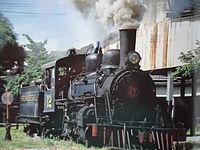Rail transport in El Salvador
As of 2022, no trains are operated inEl Salvador.The national railroad corporation isFENADESAL(Ferrocarriles Nacionales de El Salvador), a division ofCEPA(Comisión Ejecutiva Portuaria Autónoma, port authority). It oversees 554.8 km of all disused3 ft(914 mm)narrow gaugelines connecting major cities (San Salvador,Santa Ana,Acajutla,Sonsonate,Soyapango,Zacatecoluca) and formerly linked withGuatemala railroadsatAnguiatú.[1]
History[edit]

The first railroad in El Salvador was opened betweenSonsonateand the port ofAcajutlaon June 4, 1882, by the British private company The Salvador Railway Construction Co. The first locomotives were American Tai models, built in England.[2]In the following years, the lines extended to Santa Ana, San Salvador and other places. Parts of network were managed separately byThe Salvador Railway Company Limited(later nationalized and renamedFES- Ferrocarril de El Salvador) andIRCA- International Railways of Central America (aUnited Fruitcompany, later nationalized and renamedFENASAL- Ferrocarril Nacional de El Salvador). In 1975, based on a governmental decree, the two companies merged intoFENADESAL- Ferrocarriles Nacionales de El Salvador, managed and administered byCEPA(port authority) on behalf of the state.[3]
All rail transport was suspended in October 2002. Passenger trains between San Salvador andSoyapangowere briefly restored from October 2004 until April 2005 to help alleviate traffic congestion after a collapse of a road bridge which connected these two cities.[4]
In 2006 CEPA presented a pilot scheme for reviving the rail network. Commuter services could be introduced between San Salvador and Apopa, requiring the refurbishment of seven passenger vehicles.[5]
In November 2007 the CEPA plan was put into effect and the service to Apopa was restarted with two return trips each morning and evening aimed at commuter traffic. The fare was 10¢USfor the 12 km trip, and to ensure safety four police officers rode each train (service was suspended from 2013). The plan was to reopen the whole route to the provincial capital of Sonsonate in stages over the next 12 months, with the next stage being Nejapa.
On 26 April 2022, theLegislative Assembly of El Salvadorpassed a law to begin construction of theTrain of the Pacific.The new rail network will be 332 miles (535 kilometers) long.[6]
See also[edit]
References[edit]
- ^Rehabilitation in progressArchived2010-03-06 at theWayback Machine
- ^"Un viaje al pasado: ¿Cuáles fueron las primeras locomotoras que llegaron a El Salvador y dónde están ahora?".22 August 2019.
- ^FENADESAL siteArchived2007-03-12 at theWayback Machine
- ^FENADESAL siteArchived2006-10-20 at theWayback Machine
- ^"Pointers".Railway Gazette International.2007-01-01.
- ^Magaña, Yolanda (26 April 2022)."Aprueban Leyes para Construir Tren y Aeropuerto del Pacífico"[They Approve Laws to Construct the Train and Airport of the Pacific].diario.elmundo.sv(in Spanish).El Mundo.Retrieved8 September2022.



